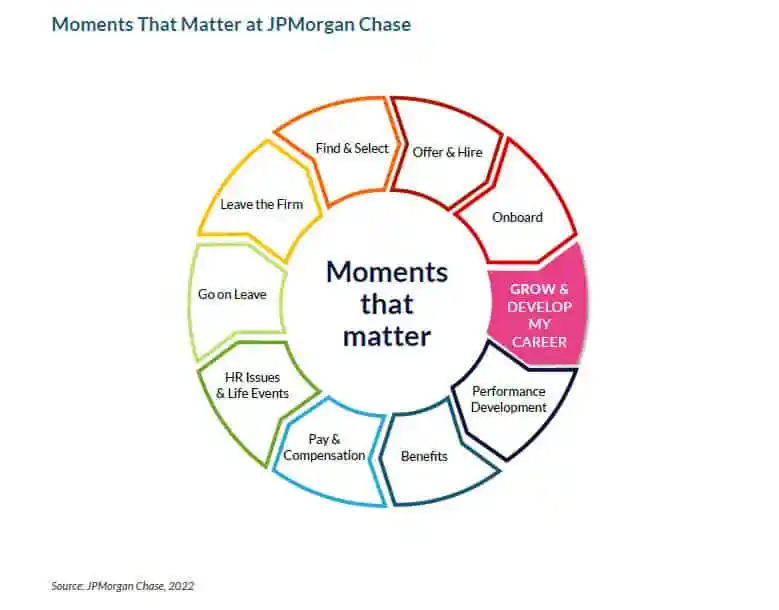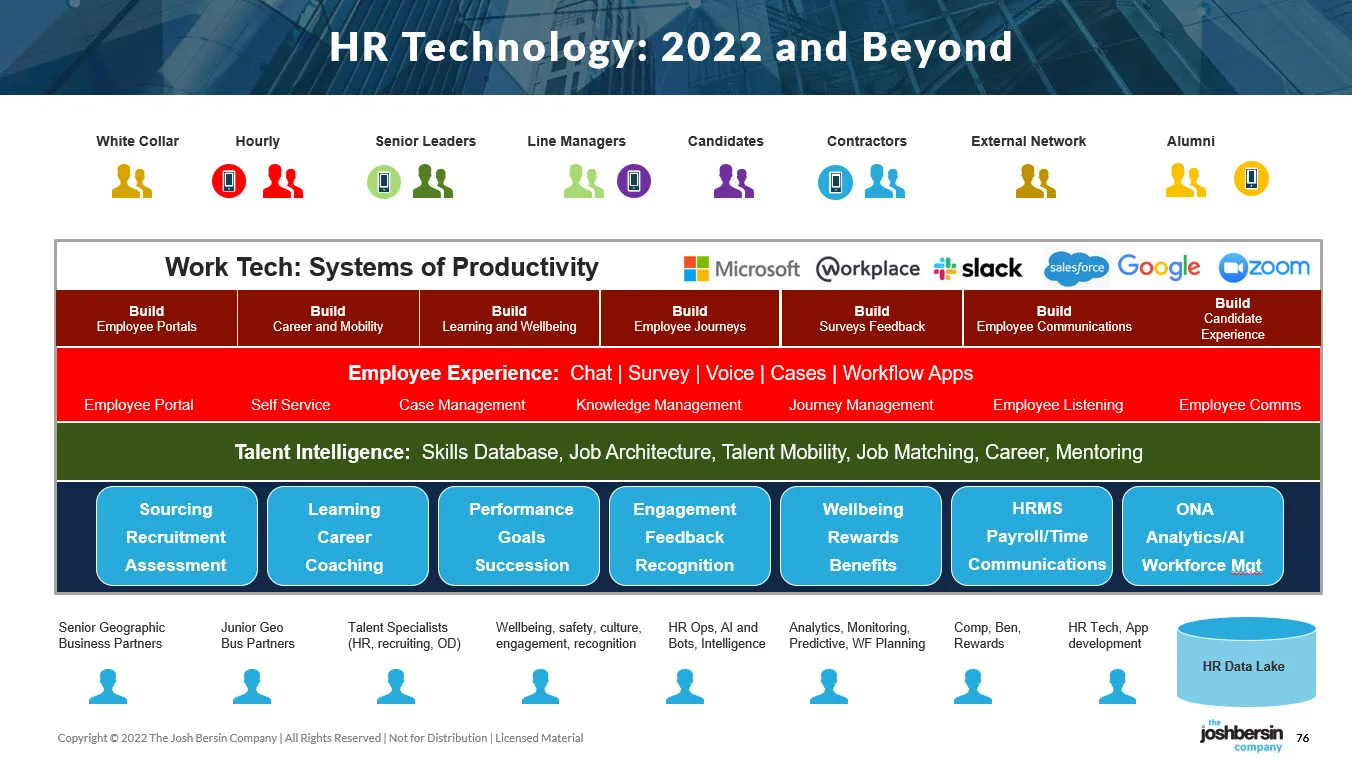We just completed two years of research on cloud-based HCM (human capital management) systems and the results are striking. Among the 35+ implementations we studied, the findings are now clear: these systems do much more than clean up IT systems: they transform the employee experience.
Just to be clear, the cloud as a computing infrastructure is only about 15 years old. Prior to this approach companies licensed and installed massively complex systems, often running them on mainframes or their own internal systems. These data centers were a big investment for companies, as they hired systems administrators, database experts, and IT engineers to operate them.
Along came the cloud (pioneered by Google, Workday, SuccessFactors) and organizations were told “you don’t need to worry about this anymore.” This fluffy white “cloud” of computing will be managed by your vendor, so all you need to do is configure and implement the system.
In the early days vendors promised innovation (faster upgrades), reduced cost, and dramatic ease of use. While these were all good ideas, initially many of these benefits did not occur.

Why the missed expectations? Well to make it simple, these are highly complex, difficult to build systems. The typical cloud HCM system (Workday, Oracle, SAP, Darwinbox, ADP, Ceridian, and others) has hundreds of modules, it needs to manage payroll in dozens of companies, and it requires dozens to hundreds of product managers to keep it up to date. So while buyers believed these systems would make life better, they were very difficult to implement.
Since then, however, the systems have become more flexible. Many customers now implement them “out of the box,” with some (Air Asia, for example) going live in a few months. And integrators, which often charge clients millions of dollars for implementation, know how to implement these systems quickly.
Vendors have also adapted. The early cloud systems were very hard to use. Now, 15+ years into this market, winning vendors have acquired many of their competitors and have massive engineering, product, and technology teams at work. They have studied employee needs and their systems are much easier to use. You, as a corporate buyer, are getting the benefit of a large team of technologists to help you do your job.
One promise was not fulfilled: it’s not clear that the cloud has saved money. Outsourcing IT and cloud engineering makes these systems expensive. Despite that issue, however, the cost of an HCM system is not that high (it’s in the $1000s of dollars per year per employee), so companies are absorbing the cost.
And the costs have not slowed down. New research by OKTA shows that the average large company now has 80+ employee systems, so IT spending on the workforce continues to go up. Now, as Microsoft enters the market, I believe a new price war is likely to emerge.
HCM PLatforms Are Now Employee-Facing Systems
Let me highlight a few of the clients in our most recent study. JP Morgan Chase implemented their now Oracle-based platform by entirely focusing on employee needs. Working as an integrated HR and IT team, they mapped out hundreds of “employee journeys” and then made sure each of these workflows were designed into the system. This seems like a lot of work, but it’s necessary.

As you can see from this model, there are a lot of experiences to consider. Every one of the segments above has dozens of sub-processes to consider, and each one of these experiences has options. Should it be self-service? Delivered by a local business partner? Or handled by the call center or HR service center?
You get to make these decisions, and ultimately that’s why these platforms are so important. In the most successful implementations (JP Morgan Chase, Marks & Spencer, McDonald’s, Air Asia, and others), the HR and IT teams work with an integrator to make a lot of business decisions. So these are not just “software implementations” – they are business transformations.
 The Maturity Model For HCM Implementations
The Maturity Model For HCM Implementations
Consider the model we developed. You can look at HR technology as a software project, but that will not really give you much of a return. You really have to look at these platforms as “transformation” platforms – they force you (and give you the opportunity) to rethink how your company operates.

I know one large Workday customer, for example, who focused entirely on using Workday as a back-end transaction system, not even considering the employee experience. While the system does what it’s expected to do, its actual employee experience has suffered. They’ve spent the last seven years building and buying other front-end systems on top of Workday. Today they’re rethinking the whole process.
Job Architecture and Job Model Decisions
These systems force companies to look at one of the most strategic things in the business: job architecture. If you just cut and paste all your job titles and job descriptions into the new system you’re going to end up with what I call the “kitchen drawer problem.” Ever notice how your kitchen drawers are filled with tools you don’t use? That’s what happens in companies. We hire people, create job reqs, and over time we end up with a mess.
A new HCM system gives you the opportunity to rethink this. As I discuss in my upcoming book Irresistible and in our Org Design research, companies really have to simplify their job architecture. You should not have more than 7-8 job levels in the company and most of the “details” about a job should be left to the manager, not typed into the HCM system. There are lots of gritty issues to discuss here, but let me just tell you the most successful implementations did rethink their job architecture in the new system.
Today internal mobility is a huge priority. You should be considering this in your implementation. Not only do most of these systems have internal talent marketplace platforms, they will open the door to vast improvements in internal recruiting. So you have to decide: how will someone apply for, accept, and take a new internal position? Will their salary be adjusted and what will their new job title and level be?
These are all important design decisions to make – the HCM system won’t make them for you.
More, Better, And Extensive Data
Often the biggest reason for a new system is to get better data. McDonald’s, for example, has many dozens of global payroll systems to handle its employees and franchisees all over the world. One of their biggest priorities was to build an integrated employee database. But this lead to many questions.
Should the new, integrated database, have employee skills? What employment, education, and other data should we capture? Who is going to make sure that data is up to date – the employee? The HR business partner? This goes on and on.
Today, as Talent Intelligence grows in importance, you’re going to want to dig into this heavily. If you want to understand Talent Intelligence (it’s the next big thing after People Analytics), check out this video. We can help you with this whole area if this is new to you.
https://youtu.be/Sf8Tlt6y5N4
Incidentally, many of the existing HCM systems are not easy to change. We have Workday clients, for example, who have to “reimplement” the system because these decisions were not made well. (GE, for example, is rethinking its entire HCM implementation as it splits into three new businesses.)
This is why many companies are “delayering” their HCM strategy. Rather than put all the intelligence and data into the HCM system, they’re using talent intelligence platforms like Eightfold or Gloat or Cornerstone/EdCast to hold this intermediate data. These are important architectural decisions.
De-Layering The HCM
Here’s what I’m getting at. The most successful companies make clear architectural decisions about what data will go where. Microsoft, for example, made a very deliberate decision to put all their global employee business rules into their global SuccessFactors system. This gives the company total freedom to deploy global hybrid work policies, pay policies, and career programs that each country can implement on their own.
Other companies, like MetLife and Walmart, put some of these business rules into the employee mobility or talent mobility system (ie. Gloat or Eightfold), because their HCM implementation is already in place.

One of the most important changes taking place in HCM is the emergence of the Employee Experience platform layer (the red layer above). These systems, which include ServiceNow, Microsoft Viva, and smaller vendors like Applaud and others, are designed to give you a single employee interface when there are multiple backend platforms. And this is the reality in many cases.
I typically find that big companies “re-platform” their HCM every 7-10 years. In between they grow, acquire companies, and open new operations – often creating multiple HCM databases and multiple payroll systems. In the case of Microsoft and Allianz, who are big SuccessFactors shops, they very deliberately integrate these new systems into their core infrastructure as part of the M&A process.
But for many younger and smaller companies, this discipline does not exist. So you end up with multiple HCM systems regardless of your best intention, so it makes sense for the EX layer to operate separately. ServiceNow, which is the dominant player in the red area above (but Microsoft is coming on strong), just acquired a talent and skills technology company (Hitch) to build out this architecture from the top down. So you can see where this is going.
As I discussed in a keynote a few years ago, there is a “holy war” going on in the HCM vendor community. Every vendor wants your employees to use their system first. So you, as an architect, need to decide what layers you want.
Success In HCM Is About Design
This leaves me to my final point. As I discussed in the keynote to our
Irresistible Conference, you are in the driver’s seat here. Don’t let the vendor force you to use all their tools. Some of them are mature and some are not. You have to decide, through a series of business decisions, what parts of the system will be implemented in each vendor.
I wish it was possible to have one end-to-end HCM platform. It just is not possible. As the OKTA identity management study points out, the average large company has more than 80 employee-facing systems. And this will never change. Your job is to think like an architect and consider your business needs and employee experiences first. Then, working with a consultant like TCS, you can decide what functions go into what layer of software.
And the key criterion is “ease of use” and productivity – not which system has more features. If your HCM system does not make people more productive and gives you the data to grow the business, then you may just want to keep what you have today. Remember that HCM systems are living, breathing things – you have to constantly take care of them since they are helping you with your single largest investment.
We Are Here To Help
Here is an
overview of the research. If you want help with your HR Technology strategy please contact us, or join our
Corporate Membership and we’ll share all the details.
Additional Resources
New Research: HCM Best Practices
Realizing The Promise Of The Cloud: Six Best Practices
Learning Technologies and Platforms: 2022
Cornerstone Acquires SumTotal From Skillsoft for $200 Million
Oracle Introduces Employee Experience Platform
Update From Workday Innovation Summit: Lots Of Growth Ahead
BY
JOSHBERSIN
SOURCE
New Research: Cloud-Based HCM Can Redefine Employee Experience – JOSH BERSIN




